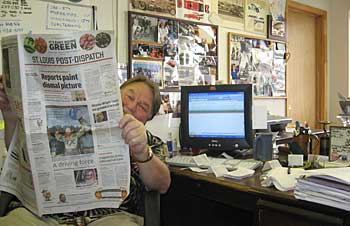Racing Net Source LLC
114 E. Elm St. , Ste. 8O'Fallon, MO 63366-2642
636.272.6301 / fax 636.272.0412

DRAG RACING Online will be published on the 8th of each month and will be updated throughout the month.
DRAG RACING Online owes allegiance to no sanctioning body and will call 'em as we see 'em. We strive for truth,integrity, irreverence and the betterment of drag racing. We have no agenda other than providing the drag racing public with unbiased information and view points they can't get in any other drag racing publication.
EDITORIAL |
|
Editor & Publisher, CEO |
Jeff Burk |
Managing Editor, COO |
Kay Burk |
Editor at Large |
Bret Kepner |
Editor at Large, Emeritus |
Chris Martin |
Bracket Racing Editor |
Jok Nicholson |
Nostalgia Editor |
Jeff Utterback |
Contributing Writers |
Jim Baker, Darr Hawthorne, |
Australian Correspondent |
Jon Van Daal |
European Correspondent |
Ivan Sansom |
Poet Laureate |
Bob Fisher |
Cartoonists |
Jeff DeGrandis Kenny Youngblood |
PHOTOGRAPHY |
|
Senior Photographer |
Ron Lewis |
Contributing Photographers |
|
PRODUCTION |
|
Creative Director/ Webmaster |
Matt Schramel |
Production Assistant |
Clifford Tunnell |
Site Programmer/ IT Consultant |
Adrienne Travis |
ADVERTISING |
|
| Director of Sales | Darr Hawthorne 818-424-6656 |
FINANCIAL |
|
| Accounts Manager, Chief Financial Officer | Casey Araiza |
- Agent 1320
- At the Back Door (caption contest)
- Letter to the Editor (for publication)
- New product press releases

© 2006-2020, Drag Racing Online
and Racing Net Source LLC

Please, Not Again…
 “I’m tired of burying my friends.” - Tim Wilkerson
“I’m tired of burying my friends.” - Tim Wilkerson
All I can add to that is, amen, brother.
As I sit here trying to come to terms with yet another death in the sport that I love so dearly I’m looking at a list. On that list are the names Johnson, Nix, Bailey, Russell, Medlen, and Kalitta. I’m trying to come to terms with the fact that all the racers on the list have had serious crashes in a nitro car and died. They were all National Event winners and some were World Champs. I knew each of the guys on that list on a personal basis except Darrell Russell, and each of their deaths affected me deeply.
Their deaths - along with John Force’s serious and possibly life threatening crash last fall – and many deaths at the drags you never read about or see on TV is what has driven me to champion driver safety throughout my profession as a journalist. I like to think I had at least a little part in making drag racing professional class drivers wear a HANS-type device for their own safety.
I’ve made the case repeatedly here for shorter tracks and slowing down the cars for both the NHRA and IHRA, and have caught a lot of heat from friends, peers and racers for my opinions. Mostly their argument was that, by God, drag racing is a quarter-mile sport and any other distance, like a 1/8th mile or 1000 feet, was just not drag racing. How dare I advocate slowing down the cars for safety sake, they asked.
I listened to them and occasionally thought perhaps they are right, maybe I’ve just gotten old and lost my passion for drag racing but I realized after hearing about the death of Scott Kalitta that I was wrong to doubt my original instincts.
Drag racing, in many instances, has just gotten too fast for most, if not all, of the tracks we race on. They are all too short to safely allow a driver to stop a 2500-lb race car going over 300 mph when problems develop. That is a hard fact. Nitro racing and for that matter almost all classes in drag racing from brackets up have exceeded the design limitations of the quarter-mile tracks they race on. Many of the tracks were designed when a nine-second, 150 mph pass was bad fast. There really isn’t a single National Event track in the nation that was originally designed with the idea 2500-lb race cars racing the quarter-mile in 4.5 seconds at over 330 mph.
Tracks aren’t even designed to safely contain a 3,000-lb+ Pro Street car that runs in the low six-second range at over 200 mph those kinds of race cars simply didn’t exist when the tracks were built. Drag racing’s motto ought to be “We can’t hope to stop them, we just want to contain them.”
The truth is that the major sanctioning bodies’ leaders don’t have the spine to say to their star racers or team owners; “You are going way too fast and we are going to take major steps to fix that.” Instead, they act as if the millionaire team owners can’t afford to change their engine or anything else, or they listen to the whining of some tuners who want the status quo and don’t want to start over with a tune up.
So, instead of taking the major and obvious mechanical changes to slow down the cars, they instead put on rev-limiters, force all the teams to build new EXPENSIVE cars, tinker with the nitro percentages, try to make Goodyear build tires never designed for the speeds they are running better, and promote other band-aid fixes - as if those efforts were saving the teams money. Don’t they realize that in order to make today’s heavier cars run 4.50’s at over 330 the crew chiefs have to run the engines, tires and chassis at the edge of their design limits?
Did they honestly believe that making drastic rule changes to slow down the cars would cause Budweiser, U.S. Smokeless Tobacco, Monster Energy drink, CSK, the U.S. Army, UPS or any of the other major sponsors to leave drag racing? Did they think the racers who have those sponsors were going to quit and give those sponsorships up? Do they honestly believe that if they take action to make the racing safer and slow down the car that the racers backed by the sponsors I mentioned above will give them up and get out of the sport? That isn't going to happen.
Since the tragic death of Scott Kalitta, suddenly people who were dead against it are now advocating shortening the NHRA track distance to 1,000 feet, as if an extra 320 feet of shutoff is going to solve the problem. I don’t think it will; I used to but I don’t now!
The answer is a dramatic change in drag racing for the good of the whole deal. Years ago when NASCAR, CART, IRL and even F-1 decided their cars were too fast they didn’t shorten the tracks, they made wholesale changes in the engine combinations and forced the cars to be slower.
I hear all of this crap about how drag racing will lose its identity and fans if we don’t have four-second, 300-mph cars. Limiting race cars’ top speeds haven’t adversely affected any other racing/entertainment series as far as I can tell.
What a steaming load of logic it is that says drag racing’s appeal to the fans and sponsors is tied to four-second, 300-mph cars. If that were the case no one would lack for a sponsor, drag racing would be on CBS and we’d have 100,000-seat stadiums.
In my opinion the best years financially and growth-wise for the NHRA came long before Kenny Bernstein broke the 300-mph barrier early in 1992. Before that historic day, drag racing had at one time three healthy series in the NHRA, the IHRA and the AHRA, and no one except rocket cars ran under five seconds or over 300 mph. And incidentally, all of the drivers on my list died in crashes after 1992!
If the tracks are to be shortened for safety then shorten them to an eighth of a mile, because 1,000-foot tracks will still yield 300mph speeds. In my opinion a move to 1,000-foot tracks would be just another band-aid fix for the problem. Slower top speeds would help.
On the Sunday after Scott’s death, U.S. Nationals winner and Funny Car/ Top Fuel driver Jim Head stated on television that most of the mechanical and driving problems associated with the nitro-burning cars usually came after the eighth mile, and certainly after 1,000 feet. He went on to say most of his driver friends were ready for shorter tracks.
There is absolutely no doubt that if he had been racing on a shorter track Scott Kalitta would be alive today.
Also, may I add that drivers themselves have got to start taking some responsibility for their own safety. If there is a boom truck in the shutoff, a gate open in the guard wall, or a ramp jump in the middle of the track, you have a duty and responsibility, not to your sponsor or car owner, but to your family to park your racer ego and just tell them you aren’t going to drive a car down that track. At some point intellect has to trump ego.
So, here’s my own quick and easy solution for the problem at hand. If your race car goes over 210 mph you race to the eighth mile; slower than 210 and you can run the quarter mile. Simple enough isn’t it? And no one’s parts or cars would be made obsolete, and maybe, just maybe, we won’t have too many more funerals for nitro racers.
‘Cause like the man said, “I’m tired of burying my friends.” And as for me, I’m tired of reading the obituaries.

Recent Stories
- Burk's Blast - NHRA drag racing's history and tradition is not measured in feet![7/3/2008]
- Burk's Blast – Just Wondering: Speed, is that all there is?[6/30/2008]
- Burk's Blast - So many questions for the NHRA and IHRA[6/17/2008]
- Burk's Blast - What the hell is going on?[6/10/2008]
- Burk's Blast - Still Wondering[6/2/08]